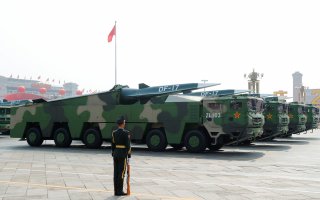What Makes China’s DF-17 Hypersonic Missile So Deadly?
It's difficult to shoot down.
Here's What You Need to Know: America cannot shoot these missiles down and has no similar kind of weapon.
Beijing’s first hypersonic weapons system, the DF-17 stands as one of the most militarily consequential additions to the People’s Liberation Army’s missile roster in recent years.
The DF-17 was first unveiled in 2013. It entered service in 2019—on the heels of at least nine tests—after making its debut at China’s 70th anniversary military parade. The DF-17 is a medium-range ballistic missile that is mounted to a DF-ZF hypersonic glide vehicle (HGV). The missile boasts a reported range of up to 2,500 km, and is deployed from a mobile transport-erector launcher (TEL). U.S. intelligence sources observed in 2017 that the missile is remarkably accurate, with the purported ability to land “within meters” of intended targets during a series of field tests. Chinese state media stressed that the DF-17 is meant for conventional-only missions, but there is seemingly nothing stopping it from carrying a nuclear warhead.
As a HGV system, the DF-17 is fired from a regular rocket booster—in fact, likely the same booster that is currently used by the DF-16B short-range ballistic missile. After climbing to near-exoatmospheric altitudes, the missile separates and uses a hypersonic glide vehicle to find its target. The HGV’s sheer speed, lower trajectory, and ability to maneuver mid-flight makes it a potent tool for penetrating sophisticated enemy defenses in scenarios where more conventional systems would likely falter. Whereas traditional reentry vehicles descend at a predictable trajectory, the DF-17 HGV’s ability to alter its flight path leaves a much smaller window for detection and tracking by enemy missile defense installations.
The state-connected Chinese publication Global Times boasted that the DF-17 renders the U.S. network of missile defenses in East Asia obsolete: “U.S. air defense systems including THAAD, SM-3 and Patriot missiles deployed in South Korea, Japan, the island of Taiwan and on U.S. warships will not work against the DF-17.”
Despite prior speculation to the contrary, Global Times argues that Beijing has no need to deploy the DF-17 against Taiwanese military infrastructure: “The PLA Rocket Force’s older generation missiles are already sufficient to wipe out most of Taiwan’s key military installations, and the island is not capable of intercepting them, so it is not necessary to use the DF-17 against the island’s military, Chinese mainland experts said.” Rather, the missile will serve as a regional threat against land-based U.S. infrastructure and Aircraft Carrier Strike Groups.
In recent months, unverified reports emerged that an air-launched DF-17 variant is in the works. If true—and if the air-launched variant is capable of performing on the same level as its ground-based counterpart—the DF-17 may pose a credible threat to distant U.S. assets like the Guam Naval Base.
With the DF-17, China joins Russia as one of just a handful of states to deploy hypersonic missiles. Washington currently lacks parallel capabilities: “The U.S. does not “have systems which can hold [China and Russia] at risk in a corresponding manner, and we don’t have defenses against [their] systems,” said Under Secretary of Defense for Research and Engineering (USD[R&E]) Michael Griffin during a testimony to Congress.
The U.S. military is developing a slew of hypersonic delivery systems that are projected to enter service in the early 2020’s and to reach operational maturity by the turn of the decade.
Mark Episkopos is the new national security reporter for the National Interest.
This article first appeared earlier this year.
Image: Reuters

